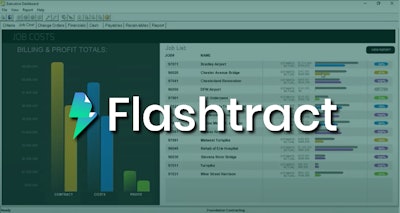
Those who follow construction technology likely noticed yesterday’s announcement of a $15 million series A financing round for Atlanta-based construction payment application vendor Flashtract.
Flashtract’s platform creates a contiguous digital workflow for billing and payment, automated lien waiver collection, digital signatures, insurance tracking diversity and inclusion tracking. The Series A funding round, led by Addition and Shine Capital, will fuel further development of these capabilities and streamlined communication channels between general contractors and subcontractors.
Application for payment is a challenging business process for both generals and subcontractors, and a commercially viable solution that automates and eliminates the non-value-added work involved in getting paid is understandably an attractive investment for venture funds.
More than slick software
But Flashtract is hardly the only company in this space. Construction enterprise resource planning (ERP) applications also seek to streamline application for payment, and there are other point solutions in the space including Levelset and GCPay. Of these two competitors, Levelset was perhaps most progressive in its approach to the market, embedding into their product a multi-vendor marketplace (MVM) for attorneys who can help with collection efforts and lenders who can provide gap financing if a contractor’s customer is slow to pay. Levelset was in September of 2021 acquired by construction ERP leader Procore.
Levelset is not alone in embedding financing e-commerce platform in its product—close on the heels of the Levelset-Procore deal Flashtract took this step in November of 2021, making it more unique as a point solution once Levelset became part of Procore and ostensibly ripe for absorption into the enterprise suite. General contractors using the company’s Flashtract’s Flash Prime application and subcontractors using the Flash Specialty product can protect their cash flow despite any payment delays even as the rest of the Flashtract toolset mitigates risk and reduces the level of effort to get applications for payment accepted by the owner. The lending option is a whitelabeled offering from Lendflow, which had a similar arrangement with Levelset and with Procore even before the Levelset acquisition.
The availability of financing directly in the context where it is needed, so lenders have full visibility into the projects and commercial arrangements they are supporting, will make Flashtract appealing to contractors who want and need a streamlined and predictable approach to getting paid but who are disinterested in a more enterprise-wide application like Procore.
SaaS pricing models evolving
As ForConstructionPros.com debriefs growing construction software companies, we are seeing a number of them either already or seeking venture financing to embed financial and other services offerings in their product. This can be a market differentiator but also, to the extent they can monetize the commerce going over their platforms, generate revenue that is not tied directly to a level of effort to deliver the software—which means it goes right to the bottom line.
This is only one way in which software-as-a-service (SaaS) pricing is evolving. A significant percentage of companies, including those serving the small-to-medium business (SMB) space leveraging various forms of value-based pricing. Under this pricing model, the software is not sold by named or concurrent user, but by volume of transactions sent over the system, either in a metered fashion or through negotiation based on projected business benefits.
This also has the effect of decoupling revenue and ultimately profit from the expenses involved in developing, delivering and provisioning enterprise software, again making a company like Flashtract attractive to venture capital investors.
“The proven value of our product is directly tied to its ability to quickly receive, review, and approve pay applications,” Flashtract Co-Founder and Head of Customer Success Ben Conry said in an email interview following the announcement. “We also frequently release features across all customer tiers because those features actively help optimize processes and reduce the cycle time in approving the pay application and paying the subcontractor. Based on this value, we charge a SaaS fee for the ongoing enhancement of the product as well as a fee--based on annual approved pay apps.”
Reliable application for payment functionality
As a point solution competing at least some of the time with enterprise suites like Procore, Flashtract needs to do the application for payment process better, and according to Conry, they are well positioned here, while minimizing the level of effort required to send data from their best-of-breed software into a system of record like an accounting solution or ERP.
“While many of the existing players have developed powerful project management or accounting solutions, the billing and payment process is really the bridge between the two,” Conry said. “Flashtract enables users to have full control over that process by connecting valuable accounting data and project management information, ensuring each party is paid correctly and on time. Understanding the value of building that bridge is why Flashtract has placed a heavy emphasis on building partnerships with the leading accounting and project management solutions.”
While the solution may not handle the earned value management (EVM) requirements of an engineer-procure construction (EPC) contractor, Flashtract functionality closes many of the gaps that can leak value in traditional application for payment processes.
“Percentage complete, work completed this period, or materials stored is input by the end users which is then used to generate all payment applications, lien waivers, and other compliance documents before being sent through a configurable approval workflow,” Conry said. “Flashtract’s application then validates these numbers against the agreed upon scheduled value and issued change orders to ensure that there is no risk of overbilling. Additionally, once given the values for a given period, Flashtract does all the math on behalf of the subcontractor to calculate everything from retainage to payment due to help avoid inadvertent mistakes, all in real time. If percentage of completion disputes arise, general contractors can flag specific line items that they would like revised, which subcontractors can then adjust and resubmit in just a few clicks.”
Work and play well with others
Data does not just flow from Flashtract into ERP or to trading partners to secure payment, details from the contract are also imported from the contract itself to define what liquidity events on the project are, eliminating manual entry.
“For a majority of our customers, we pull data in directly from their ERP or project management software through an existing integration,” Conry said. “In other cases where strict control is important to the process, we have easy-to-use templates for batch uploads as well as a Customer Success and Onboarding team that is available to provide ad-hoc training, help answer any questions, and assist with data migrations.”
The connections between Flashtract and other players including Procore will become deeper and more robust, a process that will be facilitated by their integration partners application programming interfaces (APIs).
“We currently integrate using Procore’s APIs and are available on their marketplace and will be implementing Procore’s web hooks to provide our customers with more automation,” Conry said. “We’ve also partnered with Ryvit, an industry leader in integration platform as a service (iPaaS) technology, to provide an automated integration experience for ERPs like Viewpoint Vista and Sage 300 CRE.”
Bottom line
Flashtract’s features and pricing model may increase their total revenue and profit potential, which is encouraging for venture capitalists. But this robust revenue model should give them staying power and stability as the market for application for payment software, construction accounting software and construction ERP matures and consolidates. This in turn should be heartening for the company’s customers and prospects.



















